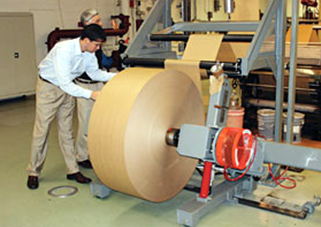
In today’s industrial world, one automated process allows for the mass production of a wide range of consumer goods and products that originates as a continuous, flexible, thin roll or strip of material. That continuous roll of material is referred to as a web, and its processing and handling plays an indispensable role in industrial production worldwide. Web materials can range from extremely thin plastics and foils to textiles, paper, metals, and composites.
What is Web Handling?
 Consider web handling as the process that converts material into product ready for mass production. Its advantage lies in it being an automated manufacturing method that allows materials to be processed in a continuous roll instead of one sheet at a time. Proper web handling requires sufficient web tension control as the material is transported through machinery for processing. Without tension being applied a web cannot be controlled. Web handling maintains web tension to minimize damage and defects, and thus waste, during processing of the material. In effect, web handling is aimed at ensuring maximum productivity and minimal waste throughout the manufacturing process.
Consider web handling as the process that converts material into product ready for mass production. Its advantage lies in it being an automated manufacturing method that allows materials to be processed in a continuous roll instead of one sheet at a time. Proper web handling requires sufficient web tension control as the material is transported through machinery for processing. Without tension being applied a web cannot be controlled. Web handling maintains web tension to minimize damage and defects, and thus waste, during processing of the material. In effect, web handling is aimed at ensuring maximum productivity and minimal waste throughout the manufacturing process.
Web Handling Applications
Web handling and processing supplies material for a number of industrial sectors – textile, automotive, durable goods, aerospace, publishing, pharmaceuticals, transportation, electronics via roll-to-roll processing, and much more. Web processing provides the manufacturing output of clothing, products such as magazines, books, and newspapers, parts for appliances, aircraft, electronics, boxes and bags, plastic sheeting, every conceivable kind of tape, flooring and floor coverings, roofing and other construction material.
Web Handling Processes
Typical web handling processes are coating, plating or laminating. As with any of the processes, the web handling system must be able to convey the web at a uniform line speed as it coats, plates, or laminates without distorting the substrate or creating defects. Proper web handling then must provide uniform line speed to ensure the process of coating, plating, or laminating is uniform.
Coating
Web coating is a process that applies a continuous layer of coating material onto a substrate such as paper, plastic or foil. Specialized coating can be applied to different kinds of substrates for different purposes. Its application is designed to enhance the properties of the material. Coating substrates has proven to be an economical approach to web processing. It’s cost effective, efficient and, with proper web handling, it can yield enormously high productivity with minimal waste.
Laminating
The web handling process of laminating is a method in which two or more flexible webs are joined together via a bonding agent. In other words, an adhesive is applied to one substrate web, and then a second web is pressed against it to produce two-layer, i.e., duplex, laminate. Web substrates for producing laminates typically consist of films, papers, or aluminum foils.
Web handling runs and controls the continuous web of material through processes and machines to ensure maximum productivity while limiting defects and losses. Whether coating, plating or laminating, web handling utilizes tension control equipment to transport the web through process machinery without flaws or defects. The end result of proper web handling should achieve increased production and product quality, while minimizing waste.



